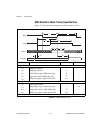
Chapter 5 Signal Timing
DIO 6533 User Manual 5-4 © National Instruments Corporation
respectively. Using only a start trigger, you can do posttrigger data
acquisition. A stop trigger enables you to do pretrigger data acquisition,
or combined pretrigger and posttrigger data acquisition. After detecting
the stop trigger, the 6533 device begins counting the post-stop-trigger
portion of the data acquisition. Figure5-4 shows trigger pulse timing,
where t
w
is pulse width.
Figure 5-4. Trigger Input Signal Timing
Instead of a pulse on the I/O connector, you can also use digital pattern
detection as a trigger to start or stop an input operation. See Chapter3,
Hardware Overview, for more information about pattern detection.
Handshake Timing
This section describes the 6533 device two-way handshaking modes
and the timing specifications of each mode.
In handshaking, the ACK signal always conveys information about
when the 6533 device is ready for a transfer. The REQ signal conveys
information about when the peripheral device is ready for a transfer.
Note: Depending on the protocol and the direction of the transfer, either an ACK
or a REQ signal can occur first in the handshaking sequence.
8255 Emulation
The 8255 emulation mode handshakes in a manner compatible with an
8255 or 82C55 Programmable Peripheral Interface (PPI). The 8255 and
82C55 PPIs are digital I/O chips used on many digital DAQ devices,
such as the National Instruments PC-DIO-24 and PC-DIO-96/PnP.
Rising-Edge
Polarity
Falling-Edge
Polarity
t
w
t
w
= 10 ns minimum


















